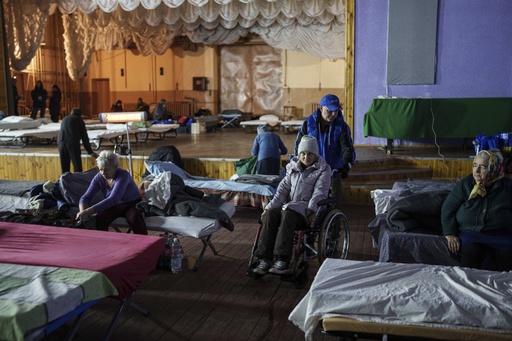
PAVLOHRAD, Ukraine — The former concert hall in this eastern Ukrainian town has transformed into a makeshift shelter, with cots now filling the stage area where music once echoed. Instead of melodies, the space is filled with the quiet sobs of locals displaced by the ongoing conflict that has persisted for nearly three years with Russia.
As the Russian military presses further into the region, towns and villages are increasingly under threat. The Pavlohrad concert hall has become a temporary refuge for civilians escaping relentless bombardments from Russia. “It’s good here. There’s food, warmth, and a place to wash,” remarked 83-year-old Kateryna Odraha, recalling her survival through the Nazi occupation of her village during World War II. However, this sanctuary could soon be at risk.
Maintaining the shelter incurs substantial costs, approximately $7,000 each month, with about 60% of that previously covered by U.S. funding designated for Ukrainian assistance. The recent decision to freeze humanitarian aid for 90 days has reverberated far beyond the political halls of Washington, reaching the civilians at the front line in Eastern Ukraine. Thousands of U.S.-funded programs aimed at humanitarian relief, development, and security have now come to a standstill as a result.
“This news was abrupt and unexpected,” Illia Novikov, who coordinates the Pavlohrad transit center run by the Relief Coordination Center, expressed. “At this moment, we have no idea what the future holds.” This U.S. funding had previously supported vital resources such as fuel for evacuation efforts, salaries for aid personnel, and essential legal and psychological support for those seeking refuge.
Typically, around 60 individuals utilize the shelter daily, but that number can skyrocket to over 200 during intensified bombardments, according to Novikov. Many residents arriving have endured months trapped in their homes, living in basements without electricity, water, or adequate food supplies.
Vasyl Odraha, 58, recounts how he remained in his village despite the increasing frequency of artillery strikes. He had initially placed his faith in the new U.S. administration, hoping for a swift resolution to the conflict. “We pinned our hopes on Trump’s election,” he said, sitting next to his mother, Kateryna. As the violence escalated and their home became perilously close to the front lines, they were forced to flee at dawn. “If we hadn’t left, we would have died that very night,” Kateryna added.
The implications of the aid freeze are being felt across various sectors in Ukraine, causing further strain on the already stretched wartime finances. Various initiatives, from energy projects and veteran support to psychological services and independent media, are now affected. Ukrainian President Volodymyr Zelenskyy has indicated that there could be a cut of $300-400 million in aid, with much of it previously allocated to the energy sector, which has been a major target for Russian attacks.
Despite the challenges, Zelenskyy noted that U.S. military assistance has not been disrupted, though Ukraine has only received approximately 42% of the funding Congress approved. The ongoing nature of the conflict provides no clear indicators that it will conclude soon, emphasizing the continued need for humanitarian assistance for Ukrainian civilians.
“Evacuations will continue for a long time,” Novikov remarked. “There may be new front lines and communities affected, so we must be prepared to keep providing assistance.”

